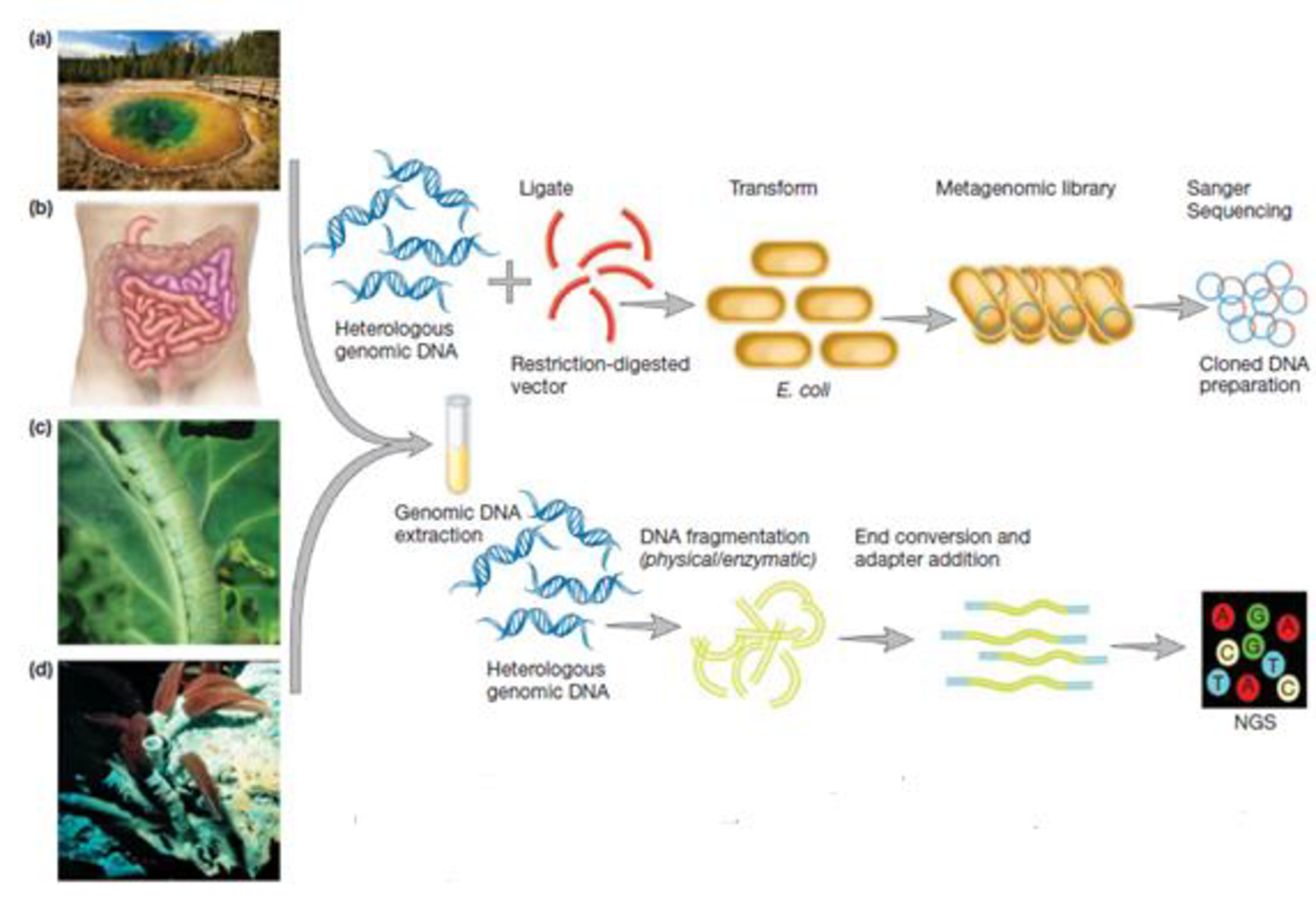
Prescott's Microbiology
10th Edition
ISBN: 9781259281594
Author: Joanne Willey, Linda Sherwood Adjunt Professor Lecturer, Christopher J. Woolverton Professor
Publisher: McGraw-Hill Education
expand_more
expand_more
format_list_bulleted
Concept explainers
Textbook Question
Chapter 18.3, Problem 3RIA
Retrieve, Infer, Apply
Examine figure 18.8. How might metagenomics be used to isolate genes encoding a potentially new antibiotic?

Figure 18.8 Metagenomic analysis. DNA has been extracted directly from environments such as (a) bacterial mats at Yellowstone National Park, (b) the human colon, (c) cabbage white butterfly larvae, and (d) tube worms from hydrothermal vents. The DNA can be used to construct a metagenomic library and analyzed by Sanger sequencing (top); however, NGS is more likely to be used (bottom), thereby avoiding the need for genomic library construction.
Expert Solution & Answer
Want to see the full answer?
Check out a sample textbook solution
Students have asked these similar questions
Chromosomal microarray, CGH, and Exome sequencing: compare and contrast!
Paraphrase and add more information
"This study will concentrate solely on the molecular characterization of seaweed samples collected on Panglao island inSouth-Central Luzon, Philippines. Molecular data will be limited to DNA sequences, with identification relying heavily on Genbank returns via blastN. The researchers would obtain their samples from the generated database and analyze the DNA barcode of each macroalgae. The researchers would also compare the previous list of discovered seaweeds from Panglao island to generate a new and updated version for this study. The research would no text end outside or to the neighboring islands around Panglao, Bohol. Neither would the researchers add or include specimens that did not appear in the database or originate from Panglao island. The data to be considered would also not discuss or include the entire taxonomic key of each available sample."
Experiment A microarray was hybridized with a mixture of two differentially labeled fluorescent cDNAs, one prepared using retinal RNA of 1-day-old mice (labeled with a green fluorescent dye) and the other prepared using retinal RNA of 28-day-old mice (red fluorescence). The two probes were prepared from identical amounts of retinal tissues and were mixed together for hybridization to the microarray. Unhybridized probes were washed away, and the microarray was photographed in a fluorescence microscope.
Chapter 18 Solutions
Prescott's Microbiology
Ch. 18.1 - MICRO INQUIRY What is the function of the 3-OH...Ch. 18.1 - MICRO INQUIRY Why is it important that identical...Ch. 18.2 - MICRO INQUIRY Which step (or steps) in this...Ch. 18.2 - Retrieve, Infer, Apply Why is the Sanger technique...Ch. 18.2 - Retrieve, Infer, Apply Explain the difference...Ch. 18.2 - Retrieve, Infer, Apply Why does reversible chain...Ch. 18.2 - Prob. 4RIACh. 18.2 - Retrieve, Infer, Apply Suggest a medical and an...Ch. 18.3 - Retrieve, Infer, Apply What is a phylotype?Ch. 18.3 - Retrieve, Infer, Apply NGS techniques are...
Ch. 18.3 - Retrieve, Infer, Apply Examine figure 18.8. How...Ch. 18.4 - Prob. 1MICh. 18.5 - Figure 18.12 Metabolic Pathways and Transport...Ch. 18.5 - Prob. 2MICh. 18.5 - Prob. 3MICh. 18.5 - Prob. 1.1RIACh. 18.5 - Retrieve, Infer, Apply How might the following...Ch. 18.5 - Retrieve, Infer, Apply What specific limitations...Ch. 18.5 - Retrieve, Infer, Apply Compare and contrast...Ch. 18.5 - Retrieve, Infer, Apply Why does two-dimensional...Ch. 18.5 - Retrieve, Infer, Apply What is the difference...Ch. 18.5 - Retrieve, Infer, Apply Describe a ChIP-Seq...Ch. 18.7 - Prob. 1MICh. 18.7 - Retrieve, Infer, Apply Cite an infectious disease...Ch. 18.7 - Prob. 2RIACh. 18.7 - Prob. 3RIACh. 18 - Propose an experiment that can be done easily with...Ch. 18 - Prob. 2CHICh. 18 - You are developing a new vaccine for a pathogen....Ch. 18 - Prob. 4CHICh. 18 - Prob. 5CHICh. 18 - Prob. 6CHI
Knowledge Booster
Learn more about
Need a deep-dive on the concept behind this application? Look no further. Learn more about this topic, biology and related others by exploring similar questions and additional content below.Similar questions
- Provide five advantages of Next Generation Sequencing? and explain each of these advantages.arrow_forwardProvide detailed explanation of the following super-resolution techniques: GSD, RESOLFT, SPDM, PAINT or DNA-PAINT.arrow_forwardwhat are advantages and disadvantages of using STRmix software in degraded DNA and DNA mixtures?arrow_forward
- Question:- Define, compare, and contrast the utility of microarray and RNAseq while analyzing gene expression levels.arrow_forwardWhat other information do you need to know if your extracts can be used for NGS sequencing?arrow_forwardPCR & High-Throughput Sequencing A. What are the three steps of PCR, including temperatures, (or ranges?) B. What are two differences between next-gen sequencing and Sanger sequencing?arrow_forward
- PCR Review: How are you able to target specific genes in PCR? What were some possible sources of error during your DNA Extraction and PCR experiments?arrow_forwardDesign a oligonucleotide probe for provided gene sequence using all the guidelines for efficient probe designing. ACAACCCCAAGCCTTCAACCACCCCCTTCCCCCAAATTAGAGATCGATCTCAAGAAGAAGAATGGGTTCCGTCTCTCGCTCTTCTTTGGATCAGAAGCTGGCCATGGCAAAGCGCTGCTCCCACGAGGGAGTTGTCGCGGGAGCAAAGGCGGCCGTGGTTGCAACTGTTGCCTCGGCCATTCCTACTTTGGCTAGCGTTAGGATGATCCCATGGGCGAGGTCCTTCCTTAATCCCGCAGCTCAGGCCCTCATCGTTTCATCAGCGGCGGGGGCGGCGTACTTCATAGTTGCGGACAAGACarrow_forwardWhat is VNTR profiling, and what are the applications of thistechnique?arrow_forward
arrow_back_ios
SEE MORE QUESTIONS
arrow_forward_ios
Recommended textbooks for you
 Human Heredity: Principles and Issues (MindTap Co...BiologyISBN:9781305251052Author:Michael CummingsPublisher:Cengage Learning
Human Heredity: Principles and Issues (MindTap Co...BiologyISBN:9781305251052Author:Michael CummingsPublisher:Cengage Learning

Human Heredity: Principles and Issues (MindTap Co...
Biology
ISBN:9781305251052
Author:Michael Cummings
Publisher:Cengage Learning
Molecular Techniques: Basic Concepts; Author: Dr. A's Clinical Lab Videos;https://www.youtube.com/watch?v=7HFHZy8h6z0;License: Standard Youtube License